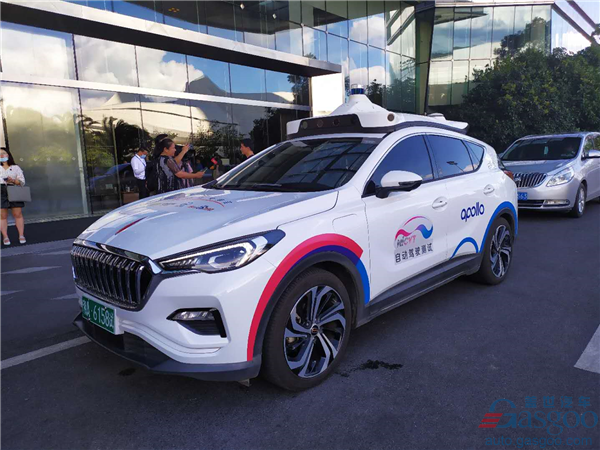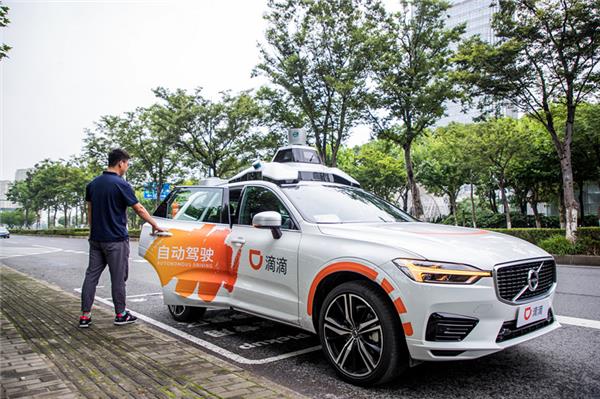Will you hail a Robotaxi via mobility service platforms?
Shanghai (ZXZC)- Hailing an autonomous driving taxi, the scenario that was previously seen in sci-fi films, has come into reality and is about to enter people's day-to-day life.

(Apollo Rotaxi in Cangzhou, photo source: Baidu's WeChat account)
On August 21, Baidu launched the full operation of its Robotaxi service “Apollo Go” in Cangzhou, Hebei province, which allows local commuters to enjoy a free self-driving taxi ride through a simple click on Baidu Maps, a desktop and mobile web mapping service application provided by the Chinese Internet giant.

(Apollo Robotaxi in Changsha)
The latest move came after the tech giant fully opened the same service in April in Changsha. However, as for the location where the service is deployed, Cangzhou is the first city in China makes the Robotaxi available in downtown.

(Photo source: Auto X)
Shortly after Baidu's significant progress in Changsha, AutoX announced on April 27 that its autonomous vehicles were available on AutoNavi's Amap app, also known as Gaode in Chinese, which is one of the most popular navigation and mapping platforms in China.
At the initial stage, users in Shanghai had the chance to experience the self-driving ride after delivering an application via the Amap, while the chance was quite rare. The public launch was announced in mid-August, which was first available in Jiading District, starting with a fleet of 100 vehicles.
Baidu and AutoNavi's launches of Robotaxi service indicate that high-level autonomous driving technologies have been gradually applied in some commercial scenarios. So, will you hail a self-driving car for your daily trip?
Baidu must be one of the players standing at the forefront of China's autonomous driving domain. In March 2019, Hunan Apollo Intelligent Transportation, a joint venture between Baidu and several Hunan's local companies and institutions, was founded for the scale operation of Apollo Robotaxi fleet. On September 26, 2019, Baidu announced in Changsha the beginning of trial operations of its Robotaxi service. From then on, local citizens can apply via Apollo's official website to be among the earliest seed users to have test rides.

ZXZC was invited by Baidu in early August to experience the Robotaxi service in Changsha. As far as I saw and heard in person, a passenger between the age of 18 and 65 can hail an Apollo Robotaxi through the Baidu Maps app or Baidu App's “Dutaxi” smart mini program after inputting the ID information and selecting the departure and destination spots from nearly 100 given options, which is quite similar to hailing a normal taxi. Unlike the traditional taxi ride, the passenger cannot change his destination during the Robotaxi trip.
During the trip, the vehicle was running at a steady speed rate under 50km/h required by local regulations. Like a human-controlled taxi, the Apollo Robotaxi is able to change lanes as appropriate, lower speed to avoid pedestrians and the vehicles that intend to overtake from a close distance, fend obstacles off and make a turn.
Most of the time, the car can drive itself without human intervention, while in accordance with the current regulations, a safety driver and a so-called “navigator” should sit at the front in case any accident happens.
According to Baidu, the Apollo Robotaxi adopts a multi-sensor solution consisting of LiDARs, millimeter-wave radars and cameras. If it merely relys on the car-borne sensors, the road conditions beyond the sensors' detection range are out of reach. However, I still was informed of such information as vehicle numbers, the countdown of traffic light timers, road works and road occupations ahead where the in-car sensors cannot detect. The “clairvoyance” effect is made possible primarily by the V2X (vehicle-to-everything) system along roads composed of RSU (roadside unit), edge computing units, intelligent traffic lights, roadside sensors, and other facilities.

The V2X system can also benefit normal vehicles equipped with connected system, so as to cut the urban traffic management cost and enhance the transport efficiency for the whole city, said the navigator.
Compared to other developers who put much more weight on the intelligence level of single vehicle, Baidu has adopted a different technical approach—the vehicle-infrastructure cooperative system. As Li Zhenyu, Corporate Vice President of Baidu and General Manager of its Intelligent Driving Group, said in an internal e-mail released in April, Baidu believes that the vehicle-infrastructure cooperative system solution will reduce the cost of developing a single autonomous car and offer greater safety redundancy guarantee.
As China's first mobility platform that launched ride-hailing aggregation service, AutoNavi has given access to over 40 car-hailing platforms in China with 100 million regular active users on the app on a daily basis.
As same as Baidu, AutoNavi also uses its navigation service App as the gateway for Robotaxi service.
AutoNavi's option to cooperate with AutoX might be for such reasons. The startup has not only forged partnerships with a number of OEMs, but also has gained the investment from two state-owned automakers— SAIC Motor and Dongfeng Motor.
On the other hand, both Auto X and AutoNavi are backed by Alibaba Group. AutoX raised a $100 million Series A last year from supporters including Dongfeng Motor, Plug and Play's China fund, HKSTP Ventures and Alibaba Entrepreneurs Fund. Thus, their cooperation can be reckoned as a tie-up formed within Alibaba Group, signaling Alibaba's offensive into mobility service area.

(WeRide Robotaxi in Guangzhou, photo source: WeRide)
In late June, WeRide become another Chinese self-driving startup that made its autonomous vehicles available for ride-hailing on AutoNavi's Amap app. Customers can hail one of WeRide's self-driving cabs via Autonavi or proprietary ride-hailing app “WeRide Go” in a geo-fenced area across the Huangpu and Guangzhou Development districts.
“WeRide implements the strategy of advancing technologies and operation simultaneously. While operating our self-built WeRide Go platform, we are opening the Robotaxi business to more and more platforms,” said Zhang Li, Chief Operating Officer of WeRide.
He added that the collaboration with AutoNavi will make WeRide's Robotaxi service hook up to maturer mobility service market, so as to let more citizens enjoy the autonomous car service.
Aside from Baidu and AutoNavi, Didi Chuxing (DiDi), China's biggest ride-haling platform, will never miss the development trend of autonomous driving.

(DiDi's Robotaxi in Shanghai)
On August 5, 2019, DiDi claimed that its autonomous driving arm had been upgraded into an independent company to focus on R&D, production application and other business development pertain to autonomous driving. DiDi's CTO Zhang Bo serves concurrently as its CEO.
On June 27, 2020, the trial operation of DiDi's Robotaxi service kicked off in Shanghai, where signed-up passengers can apply for free self-driving rides within a designated area that covers Shanghai Automobile Exhibition Center and nearby business districts, subway stations, and downtown hotels.
Compared to Baidu and AutoNavi, DiDi might be more starving for the practical usage of autonomous driving technologies as it is getting harder to satisfy the increasing car-hailing demands with the platform's current transport capacity. Robotaxis are expected to efficiently make up the shortfall of drivers.

(Photo source: Cao Cao Mobility)
Some OEM-backed ride-hailing platforms also join the Robotaxi game. Cao Cao Mobility, the ride-hailing arm of the Chinese automaker Geely, announced on August 19 its autonomous cars jointly developed with DeepRoute.ai, a Shenzhen-based full-stack self-driving solution developer, has been put into road tests and trial operation in Hangzhou after being given green light by local authorities.
According to platform, the autonomous driving fleet will be enlarged to 10 cars in the second half of 2020 and will be connected to Cao Cao Mobility's App. Besides, the test drive service is expected to be opened to the public next year. During the 2020 Asian Games, the fleet may be grow to several hundreds of vehicles, which will be deployed key areas of Hangzhou.
As the technologies are maturing gradually, using autonomous cars will greatly help elevate passengers' commuting efficiency and safety, and will enable operators to offer mobility services with uniform standards and high quality, said Rong Jian, general secretary of the ride-sharing division of China Communications and Transportation Association.
For car-hailing platforms, their deployment of RoboTaxi service is not only to reap the first-mover advantages in autonomous driving domain, but more importantly, to cope with some existing problems.
In comparison with other types of autonomous driving technology developers, ride-hailing platforms are much closer to actual mobility scenarios, making them easily grasp a vast amount of data collected from numerous taxi trips and self-driving road tests.
To cooperate with the R&D of autonomous driving technologies, DiDi is making its own high-definition (HD) maps by using the massive fleet to collect data, according to DiDi's CTO Zhang Bo.
From the angle of HD map, AutoNavi does boast greater merits. Moreover, the collaboration with over 40 ride-hailing platforms also renders an enormous data pool for the company's autonomous driving R&D.

